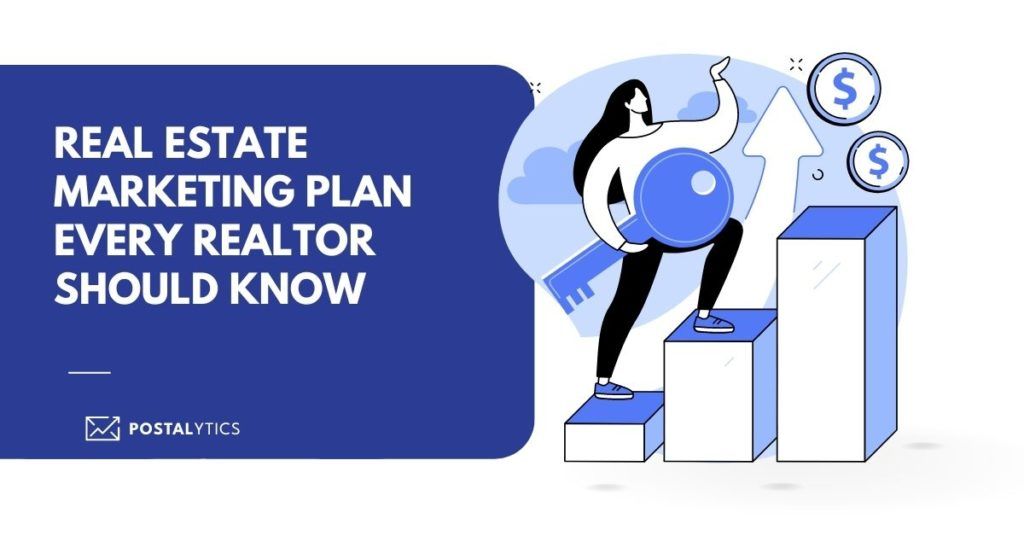
As the leading direct mail marketing automation platform, we spend a lot of time on real estate marketing plans. While most plans seem complex, some of the best ones are simple yet powerful.
Today, we’ll talk about creating a plan that generates results. Behind most performing plans, you can almost always find one marketing channel that has been around since the dawn of human civilization – direct mail marketing. And lately, direct mail marketing has become much better. No wonder real estate agents and agencies are turning to direct mail to sell some of the most ambitious products in existence – property.
Postalytics is a direct mail tool that streamlines your real estate marketing plan. It automates, prints, and ships the mail with postage sorted. There are no minimum orders, and you can track everything online.
Not sure you’re ready to commit? Check out our free demo first.
What we’ll cover:
- What Is a Marketing Plan for Real Estate?
- Why Create a Real Estate Marketing Plan?
- How Do I Write a Real Estate Marketing Plan?
- Sample Real Estate Marketing Plans
- Real Estate Marketing Plan Templates for Free
- 30-Day Real Estate Marketing Plans
- Luxury Real Estate Marketing Ideas
- The Best Real Estate Marketing Plans
- Final Thoughts
What Is a Marketing Plan for Real Estate?
A real estate marketing plan is a guide that a real estate agent creates and follows to promote themselves, generate more leads, and ultimately grow their business. While traditional advertising can still work for some real estate businesses, it’s costly and time-consuming.
Using direct mail marketing automation tools simplifies the work you need to put into the execution of your real estate marketing plan.
Once you develop your marketing plan, you can take advantage of leads and referrals.
Why Create a Real Estate Marketing Plan?
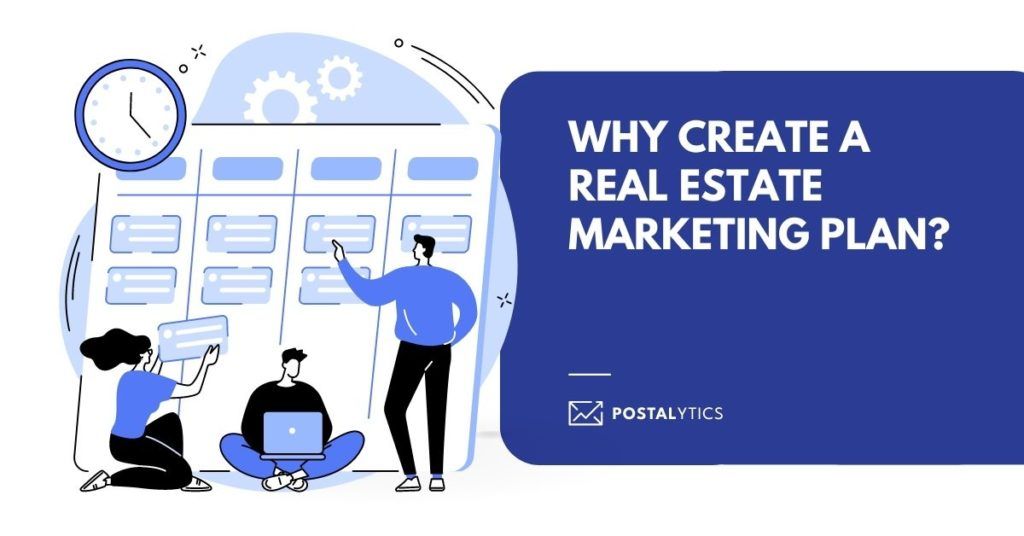
Having a solid foundation will help you build a strong and successful business. As a matter of fact, organized marketers and real estate businesses report 670% higher revenue, according to the CoSchedule study. Having a marketing plan means organizing your vision, strategy, tactics, and execution capacity to grow your business. A plan will help you get a company of people working together on the same goals. So, having a plan means a 7x difference and usually survival or a real estate business.
Once you know your WHY and WHAT, have a think about the How and execution side of things. Think about how to implement your real estate strategy. You can’t just throw money on random ads across different mediums and expect immediate results. Instead, it takes continual touches to check in with your target audience. You want to show them that you haven’t forgotten them, and you want them to remember you.
Instead of sending a stream of ads to your mailing list, you have to personalize the messages in triggered drip campaigns. Prospects will seek to connect with you. And you’d want to give them the necessary information and help them find solutions to their problems.
Real estate agents have found that using an automated direct mailer is the best way to spend their time and money. It frees them up for other work while maximizing potential leads. Postalytics lets you automate direct mailers just as you can automate an email campaign. You can send increasingly customized mail the longer someone stays on your list.
How Do I Write a Real Estate Marketing Plan?
As previously said, having a solid foundation in place will help you focus your business’s growth.
When you think of your real estate business, you need to assess where you are now and think of where you want to be. How large do you want to grow your business, and what’s your time frame for that expansion? Once you know where you want to be this time next year (no pun intended), work back from your largest goals to the tiniest details of execution.
Knowing this information primes you for writing a fool-proof real estate marketing plan.
What Are the Steps of a Real Estate Marketing Plan?
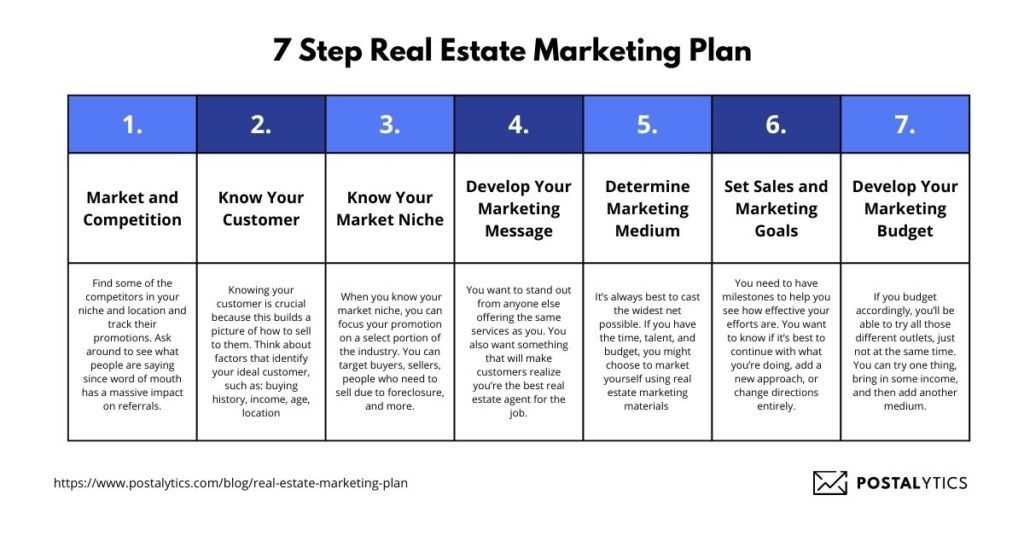
It might seem daunting to create a real estate marketing plan, but breaking it down into steps helps. You can understand each part of the process and how it plays into the bigger picture to empower you to reach your goals. Once you know the details, you can optimize them to save some money and grow much faster. So, let’s dive right into the steps for writing a great marketing plan.
Step 1 – Market and Competition: Find References
Before you jump into creating your own real estate marketing plan, check out what others are doing. Find some of the competitors in your niche and location and track their promotions. Ask around to see what people are saying since word of mouth has a massive impact on referrals.
When you ask other people about a certain real estate agent, their reactions can give you a lot of information. They might be eager to share what they know about the person. They might not know who you’re talking to. Any reaction can help you structure the rest of your real estate marketing plan to take a bigger cut of the field.
As you research what others are doing, you’ll find out what works and doesn’t work for them. Keep notes on what seems to work in certain locations or with specific demographics. If something doesn’t seem to make a difference, make a note of that too. You can learn from this research to make your real estate marketing plan bigger and better.
Watching what other realtors are doing saves you from going through a major trial and error period.
If you don’t have the luxury of talking to others (and even if you do), visit the largest modern-day forums like Reddit and Quora. Search for a community or a thread about your local real estate market. Spend some time reading through discussions and make notes of common themes, frustrations and wants. Social forums will help you understand your market and ultiamtely, this can help you connect with your prospects. And connection is everything in this business.
Take advantage of that by streamlining your marketing plan with the steps below. Having the right real estate marketing plan ensures that the potential customer won’t put your mailer in the recycling bin. Instead, they’ll hold onto it, remember your name and message, and follow up.
Finding out what your competitors are doing also gives you an advantage because you can set yourself apart. Maybe too many real estate agents are targeting growing families so that you can focus on people looking for their first home. You can use what they’re already doing to find an untapped niche that can provide plenty of clients for your business.
Step 2 – Know Your Customer
Knowing your customer is crucial because you need to connect with them to develop a strong lead generation workflow. Knowing your customer helps you streamline your marketing plan to make it easier for other people to find you. You’ll also be able to target only the most interesting segment of your market, helping you save money in the process.
To start, think about factors that identify your ideal customer, such as:
- Real estate needs
- Buying history
- Income
- Age
- Family size
- Location
- Aesthetics
- Local problems
- Schools and hospitals
If you know you want to help first-time homebuyers find their dream property, you don’t want to market yourself to people buying rental homes. Knowing who you want to work with will help you focus your marketing plan on your skills.
Step 3 – Know Your Market Niche
Once you build a fair understanding of your customer, it’s time to go an extra mile.
Trying to reach anyone and everyone will make your direct mail marketing seem expensive and redundant in places. Your message might not reach your ideal customers. It’s time to destill your exact real estate niche. When you know your market niche, you can focus your promotion on a select portion of the industry. You can target buyers, sellers, people who need to sell due to foreclosure, and more.
When people see who you can help, they’re more inclined to contact you for more information. You can also tailor your promotion to tell them exactly what you’re capable of doing for them.
And finally, this helps you build a brand in that niche. This will compound over the years and start creating excellent returns in the long run.
Step 4 – Develop Your Marketing Message
Your marketing message is one of the most important aspects of the marketing plan. You want to stand out from anyone else offering the same services as you. You also want something that will make customers realize you’re the best real estate agent for the job.
Write out your highlights and best features. You can list these as bulleted items on your direct mailers so anyone checking their mail can read them quickly. Having a catchy tagline also helps your name and message stick in the minds of potential customers.
Behind the scenes, your marketing message is the best way to set goals and assess if you’ve met them. You can track mailers going out in a certain zip code, for instance, to see if your ideal customers live in that area. Postayltics tracks everything for you, just as an email campaign manager tracks delivery.
Step 5 – Determine Your Marketing Medium(s)
It’s always best to cast the widest net possible. If you have the time, talent, and budget, you might choose to market yourself using real estate marketing materials such as:
- Personalized postcards
- Partnerships with local businesses
- Direct mail letters
- Newspaper ads
- Ads on local TV stations
- Radio ads
- Billboards and bus stop signs
- Brochures
- Email mailers
- Social media posts and promotion
Each medium has its pros and cons. If you’re targeting the older population, for example, postcards, newspaper, and TV ads might be your best bet. If you want to appeal to a broad population, investing in a billboard or bus stop sign along a busy commuter highway will give you a lot of attention. Some companies can provide demographics on who lives and drives under each billboard, so you can get a tiny bit of targeting this way.
Email, social media, and website ads are worth trying, but they’re tough to rely on. People spend a lot of time scrolling and clicking. It’s rare that they take the time to process something like an ad on a website if they’re looking for other content. Social media can help because platforms promote posts with lots of engagement, which can get you fresh leads.
Most people are yet to find out about the automated direct mail marketing, which actually makes it the perfect medium for cutting through the digital noise of today. This means your message stands a much higher chance of reaching a potential customer than in any other marketing medium.
Step 6 – Set Sales and Marketing Goals
A marketing plan isn’t just about getting your name out into the community — it’s also about setting goals for yourself and your real estate business. You need to have milestones to help you see how effective your efforts are. You want to know if it’s best to continue with what you’re doing, add a new approach, or change directions entirely.
A goal isn’t limited to making a certain amount of money or reaching a specific number of new potential clients. You can set small goals that help you realize you’re on the right track and making progress towards growing your real estate business.
Having a timeline for these goals helps exponentially. You want to think about how long you’re going to try a certain method and the expected deadline of when you’ll see the impact. You don’t want to start a campaign in March and still be waiting for results in December. A timeline can keep you on your toes, so you’re always moving forward to reach your goals.
Step 7 – Develop Your Marketing Budget
It’s easy to dream big and think you’ll try a billboard, social media ads, and a direct mailer at once. But your budget is a major component of your marketing efforts. If you budget accordingly, you’ll be able to try all those different outlets, just not at the same time. You can try one thing, bring in some income, and then add another medium.
Postalytics is upfront and transparent with its pricing. We have created different pricing models, depending on your marketing needs. For example, if you need to send 10,000 postcards, price per piece will be much lower than when sending a 1,000 postcards. You don’t have to worry about having different fees based on additional services. You can pick a plan and know exactly what you’re going to get and how it will pay off.
If you’re going for a large-scale campaign, our monthly plans are great ways to jump right in and get access to the best direct mail technology out there. But if you want to try it out without a commitment, you can use the free plan. You’ll pay per piece of mail, and there’s no minimum. That freedom lets you try out something new and see how it can work for you before you scale up.
You get discounts on the monthly plan, but it’s understandable that you want to see proof that it’s worth the investment before committing. Even the free plan where you pay per piece is a great deal for what you get. Remember, you’re investing in growing your business in a unique way. Direct mailers are a way to guarantee your message is in the hands of potential customers.
Sample Real Estate Marketing Plans
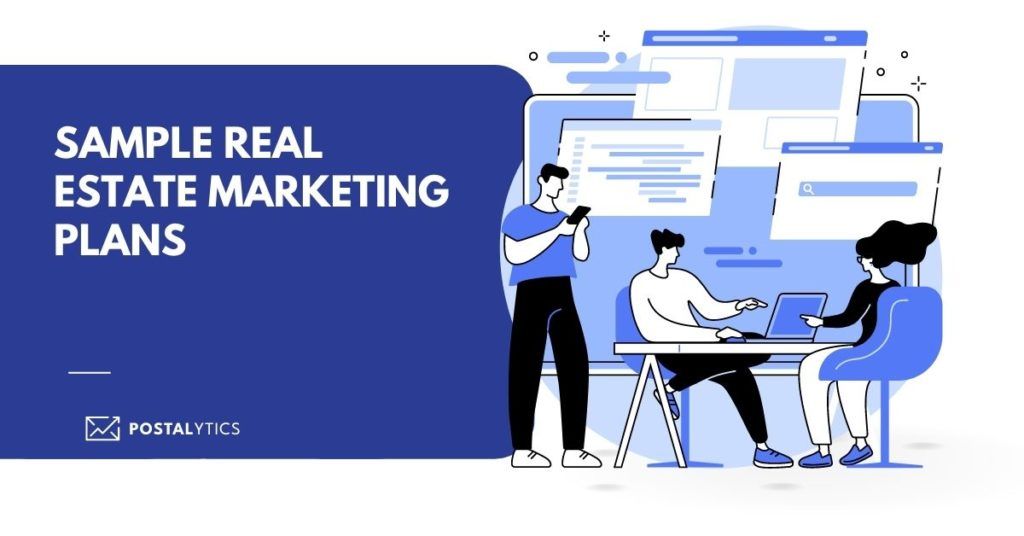
Postalytics has developed a simple marketing plan, giving you a step-by-step guide on how to get started even if you’re still finetuning your own plans.
For professionals who already have an email mailing list, it might seem like there’s too much effort needed to incorporate direct mailers into their marketing mix. Postalytics make things easy here. You can integrate with Mailchimp to seamlessly continue sending out mailing list updates. But with just a click of the mouse, you can select “Mail Drop” and automate the scheduled mailers to target your email nonresponders or to nudge them about that beautiful 5 bedroom down the street they’ve been thinking about buying.
Because you can immediately send out these direct mailers, paying per piece and tracking your results from the Postalytics dashboard, you’ll get fast results. There’s no need to choose email or mail when you can do both and reach your customers from multiple avenues, creating multiple touchpoints and staying top of mind.
You can develop different segments for various locations or certain audiences. Some might react more to a simple message, while others might want to see all your bells and whistles. Instead of spending hours crafting these mailers yourself, Postalytics simplifies the process and cuts it back to mere minutes. This also gives you additional safety, as our direct mail designer automatically complies with all the shipping standards so you don’t have to worry about stamps and design requirements.
Real Estate Marketing Plan Templates for Free
When you use Postalytics for your real estate marketing efforts, you can choose from templates. These include letters and postcards that have delivered results for previous customers. You don’t need a graphic designer or experience with layout yourself — simply input your message, and real estate logo design, and move on.
Once you have your target audience in mind, you’ll find the right template to appeal to them. You can use a Just Listed postcard template, “We Buy” template, Cash Offer layout, and more. They’re entirely customizable so you can insert the text and let the software auto-populate names and addresses for you.
30-Day Real Estate Marketing Plans
A 30-day real estate marketing strategy helps you understand how to take advantage of an intense period to grow your business. Planning this way gives you actionable steps to take each day. Instead of wasting effort trying to decide what you can do to expand your reach, the 30-day plan keeps things moving.
On the first day, you’ll set your goals. Any time you feel stuck, you’ll look back at the goal you set on day one and understand the purpose. You might aim to make a certain amount of money to gain a specific number of referrals. Everything you do in the next 29 days will push you towards this goal.
Outline the rest of your month by giving yourself one task a day. Ideas include:
- Sending out postcards (so they stay in your prospect’s home longer)
- Posting to social media about your latest offers
- Recording a video of a property or custom tip to share
- Following up with a former client via text
- Send handwritten letters to stay top-of-mind
- Sending a new email campaign
- Contacting clients for testimonials
- Updating your social media and website
These options help you expand your business in measurable ways but don’t take a lot of time or effort to do. You can schedule many online tasks and outsource others, so you’re growing your business while your focus is elsewhere.
Postalytics is a great asset to the 30-day marketing plan because they streamline the mailing process for you. It used to take a lot of time, effort, and money to create mailers, stamp and address them, and wait at the post office to mail them.
Postalytics does it all for you with no minimum order. And you get tracking and data on the mailers, which you couldn’t get the old-fashioned way. There’s no reason to not take a few minutes of one day during your 30-day marketing plan to schedule a direct mail campaign.
On the last day of your 30-day marketing plan, you’ll have a lot of data to look over. You should be able to see if you reached your goal from day one. You might surprise yourself by reaching that goal twice over! Trying this challenge is a great idea when you worry that your business has hit a plateau.
Luxury Real Estate Marketing Ideas
The luxury real estate industry is a growing niche as more people than ever are paying attention to the real estate market. If you choose to sell luxury properties, you want to make sure to make your prospects feel extra special. Otherwise, they might have no problem going away with another agent or a business.
If you want to be luxurious, you need to think about highly personalized offers and promotions. Luxury is made for people who want to feel unique, and special and those who want to impress others. Your offer has to be impressive on all levels, starting with the promotion itself.
For real estate agents who constantly have luxury properties to sell, direct mailing is one of the best real estate marketing avenues for their customers. You can target a certain area of a city and show them property on a postcard. You can set up a trigger for Happy Birthday postcards right before your prospect’s special days. Make your prospects feel valued and special, and they’ll reward you by staying loyal and buying more from you.
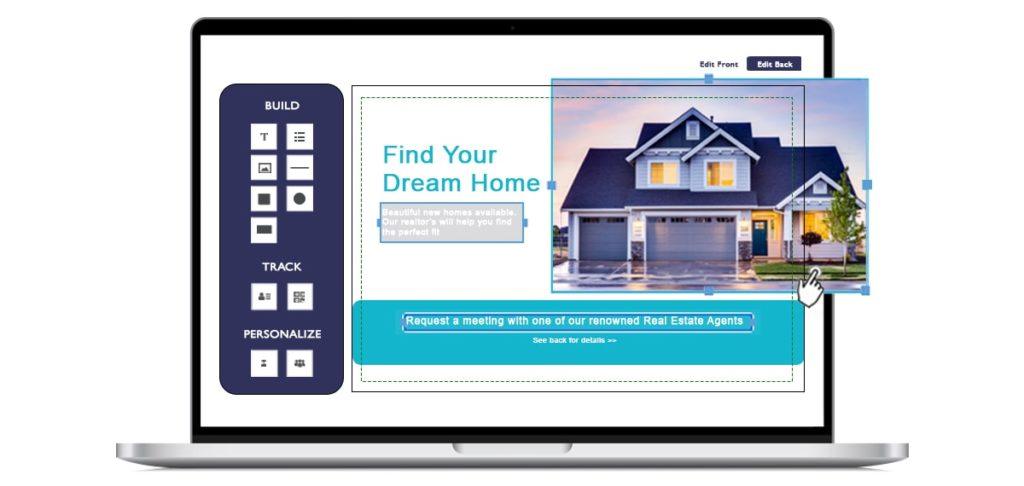
The Best Real Estate Marketing Plans
While there’s not one single best real estate marketing strategy, there’s something you shouldn’t skip over, and that’s sending direct mail in your marketing efforts. You want to corner the market in an innovative way. There’s little that’s more effective than literally getting your information into someone else’s hands.
With Postalytics, you don’t have to stress over a mailer design or postcard layout. You can use all your current mailing list and choose from a template library to create highly-effective campaigns. Since you pay per piece and there’s no minimum order, you can try mailers for a select segment of your audience to see how it performs. And with Postalytics data, you’ll get those exact numbers in real-time.
Final Thoughts
Creating a real estate marketing strategy is a great way to streamline the focus of your business and reach the target audience. You can set goals for your growth and find actionable steps to make progress. While parts of your marketing plan might seem difficult or complicated, Postalytics simplifies the direct mail marketing process so you can use your data, integrate with CRM and craft direct mailers to reach new prospects.
What are you waiting for? Sign up for your free account today!
About the Author

Dennis Kelly
Dennis Kelly is CEO and co-founder of Postalytics. Dennis joined Boingnet, the predecessor to Postalytics, in 2013. Boingnet was focused on providing print and direct mail marketing service providers the ability to add digital marketing channels to their direct mail campaigns. Postalytics is Dennis’ 6th startup. He has been involved in starting and growing early-stage technology ventures for over 30 years and has held senior management roles at a diverse set of large technology firms including Computer Associates, Palm Inc. and Achieve Healthcare Information Systems.
